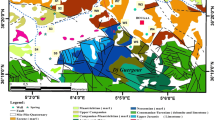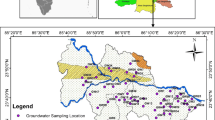Abstract
The significant geochemical characteristics of the groundwater quality assessment including the impact of monsoon variation of chemical composition of groundwater were determined. 44 groundwater samples were collected in the Arani Taluk of South India and all important physico-chemical parameters including trace metals were determined to characterize and evaluate the hydrogeochemical nature and water quality. In order to evaluate the geochemical characteristics, the order of abundance of the ions in the groundwater is determined for both seasons. In this study, Gibb’s diagram is used to evaluate the mechanism responsible for the change in the chemical composition of groundwater. The unique characteristic of the groundwater has been brought out using the inter-relationship among the principal ions. Utilizing the application of 1 : 1 equiline diagrams, hydrochemical features of the physico-chemical parameters pertaining to the groundwater were evaluated. Reverse ion-exchange study and Chloro-alkaline indices were carried out to evaluate the occurrence of ion-exchange/reverse ion-exchange in the groundwater of the region. The suitability of groundwater to irrigation is studied in detail using various ratios’ including Residual sodium carbonate, SAR and Wilcox and USSL diagrams. The results clearly illustrates that the groundwater of the study area is suitable for irrigation. Water quality studies with respect to trace metals have been carried out and the results show that the water has higher concentration of heavy metals and the results of Heavy metal pollution index also substantiates the fact and many groundwater samples found to show higher values than the allowed limit with respect to heavy metal contamination.












Similar content being viewed by others
REFERENCES
APHA, Standard Methods for the Examination of Water and Wastewater, 19th Ed. (American Public Association, Washington, 1995).
T. Cerling, E. Pederson, B. L. and K. L. V. Damm, “Sodium calcium ion exchange in the weathering of shales, Implications for global weathering budgets,” Geology 17, 552–554 (1989).
L. S. Clesceri, A. E. Greenberg, and A. D. Eaton, Standard Methods for the Examination of Water and Wastewater, 20th Ed. (American Public Health Association, American Water Works Association, Water Environment Federation, Washington, 1998).
E. M. Eaton, “Significance of carbonates in irrigation waters, Soil Sci.,” 69, 123–133, (1950).
R. S. Fisher and W. F. Mulican, “Hydrochemical evolution of sodium–sulphate and sodium–chloride groundwater beneath the Northern Chihuahuan desert, Trans– Pecos, Texas, USA,” Hydrogeol. J. 5 (2), 4–16, (1997).
R. J. Gibbs, “Mechanism controlling world’s water chemistry”. Science, 170,1088–1099, (1970).
L. Giridharan, T. Venugopal and M. Jayaprakash, “Evaluation of the seasonal variation on the geochemical parameters and quality assessment of the groundwater in the proximity of river Cooum, Chennai, India,” Environ. Monitor. and Asses. 143 (1–3), 161–178, (2008).
V. Gopal, A. Shanmugasundaram, B. Nithya, N. S. Magesh, and M. Jayaprakash, “Water quality of the Uppanar estuary, Southern India, Implications on the level of dissolved nutrients and trace elements”. Marine Poll. Bull. 130, 279–286, (2018).
J. D. Hem, “Study and interpretation of the chemical characteristics of natural water”. United States Geological Survey Water Supply Pap., No. 2254, (1985).
R. K. Horton, “An index–number system for rating water quality,” J Water Pollut. Control Fed. 37, 300–306, (1965).
F. M. Howari, and K. M. Banat,” Hydrochemical characteristics of Jordan and Yarmouk River waters: effect of natural and human activities,” J. Hydrol. Hydromech. 50 (1), 50 (2002).
Indian Standard Bureau of Indian Standards Drinking Water Specifications, IS 10500, 1991, (New Delhi, 1991).
M. Jayaprakash, R. Nagarajan, S. Muthusamy, V. Gopal, Arya Viswam, and P. Kalaivanan, “Groundwater geochemistry of Neyveli lignite mine–industrial complex, Tamil Nadu, India and its suitability for irrigation” Int. J. Adv. Earth Sci. Eng. 1 (1), 27–42, (2012).
K. R. Karanth, Hydrogeology (McGraw–Hill, New Delhi, 1989).
W. P. Kelley, Alkali Soils–Their Formation Properties and Reclamation (Reinhold Pub., New York, 1951).
N. Khatri and S. Tyagi, “Influences of natural and anthropogenic factors on surface and groundwater quality in rural and urban areas”, Front. Life Sci. 8 (1), 23–29, (2015).
X. R. Kumar, A. L. Giridharan, J. Shyamala, P. M. Velmurugan, and M. Jayaprakash, “Geochemical assessment of ground water quality in Cuddalore, Tamil Nadu, Se Coast of India,” World Appl. Sci. J. 17 (8), 1033–1039, (2012).
F. Li, Z. Qiu, J. Zhang, W. Liu, C. Liu, and G. Zeng, “Investigation, pollution mapping and simulative leakage health risk assessment for heavy metals and metalloids in groundwater from a typical Brownfield, Middle China”. Int. J. Environ. Res. Public Health 14 (7), 768 (2017).
M. Meybeck, “Global chemical weathering of surficial rocks estimated from river dissolved loads”. Am. J. Sci. 287, 401–428 (1987).
S. V. Mohan, P. Nithila, and S. J. Reddy, “Estimation of heavy metal in drinking water and development of heavy metal pollution index,” J. Environ. Sci. Health A 31 (2), 283–289, (1996).
M. A. Momodu and C. A. Anyakora, “Heavy metal contamination of ground water. The Surulere case study,” Res. J. Environ. Earth Sci. 2 (1), 39–43, (2010).
M. Mosaferi, M. Pourakbar, M. Shakerkhatibi, E. Fatehifar, and M. Belvasi, “Quality modeling of drinking groundwater using GIS in rural communities, northwest of Iran”, J. Environ. Health Sci. Eng. 12, 99 (2014).
S. Nagarajah, B. N. Emerson, V. Abeykoon and S. Yogalingam, “Water quality of some wells in Jaffna and killinochchi with special reference to nitrate pollution”. Tropical Agriculture 44, 61–73, (1988).
M. R. Naseh, V. R. Noori, R. Berndtsson, J. Adamowski, and E. Sadatipour, “Groundwater pollution sources apportionment in the Ghaen Plain, Iran”. Int. J. Environ. Res. Public Health 15, 172–189, (2018).
P. L. Nordstrom, Occurrence, Availability and Chemical Quality of Groundwater in the Cretaceous Aquifers of North–Central Texas. Report–269, (Texas Department, Water Resources, 1982), Vol. 1.
S. Obiri, “Determination of heavy metals in water from boreholes in Dumasi in the Wassa West District of western region of Republic of Ghana”. Environ. Monitor. Asses. 130, 455–463, (2007).
J. O. Odiyo and R. Makungo, “Chemical and microbial quality of groundwater in Siloam Village, implications to human health and sources of contamination”, J. Environ. Res. Public Health. 15, 317–348 (2018).
B. Prasad and K. Sangita, “Heavy metal pollution index of ground water of an abandoned open cast mine filled with fly ash: a case study”, Mine Water Environ. 27, 265–267, (2008).
A. G. S. Reddy, “Vertical variation in groundwater chemistry of Penna–Chitravathi river basin in Southern India,” J. Geol. Soc. India. 89 (6), 653–662, (2017).
D. J. Rowell, “Soil science, methods and applications.Longman Scientific and Technical Yeung IMH (1999) Multivariate analysis of the Hong Kong Victoria Harbour water quality data,” Environ. Monitor. Assess. 59, 331–342, (1994).
C. Sadashivaiah, C. Ramakrishnaiah, and G. Ranganna, “Hydrochemical analysis and evaluation of groundwater quality in TumkurTaluk, Karnataka State, India,” Int. J. Environ. Res. Public Health 5 (3), 158–164, (2008).
A. Shanmugasundharam, G. Kalpana, S. R. Mahapatra, E. R. Sudharson and M. Jayaprakash, “Assessment of groundwater quality in Krishnagiri and Vellore districts in Tamil Nadu, India”, .Appl. Water Sci. 7 (4), 1869–1879, (2017).
R. F. Stallord and J. M. Edmond, “Geochemistry of Amazon River, the influence of the geology and weathering environment on the dissolved load”. J. Geophys. Res. 88, 9671–9688, (1983).
I. A. Talalaj and P. Biedka, “Use of the landfill water pollution index (LWPI) for groundwater quality assessment near the landfill sites,” Environ. Sci. Pollut. Res. Int. 23 (24), 24601–24613, (2016).
C. Teta and T. Hikwa, “Heavy metal contamination of ground water from an unlined Landfill in Bulawayo, Zimbabwe,” 7 (15), 18–27, (2017).
T. Venugopal, L. Giridharan, M. Jayaprakash, and P. Periakali, “Environmental impact assessment and seasonal variation study of the groundwater in the vicinity of River Adyar,Chennai, India”, Environ. Monitor. Asses. 149, 81–97, (2009).
L. V. Wilcox, Classification and Use of Irrigation Waters (US Department of Agriculture, Washington, 1955).
Y. Yihdego, J. A. Webb and B. Vaheddoost, “Highlighting the role of groundwater in lake–aquifer interaction to reduce vulnerability and enhance resilience to climate change”, Hydrology 4 (1), 10 (2017).
ACKNOWLEDGMENTS
I express my sincere respect and gratitude to Dr. M. Jayaprakash, Professor, Department of Applied Geology, University of Madras for giving the valuable support and guidance for successful completion this work.
Author information
Authors and Affiliations
Corresponding author
Rights and permissions
About this article
Cite this article
Mohana, P., Velmurugan, P.M. Geochemical Characterization and Water Quality Assessment of Groundwater in Arani Taluk of Tamil Nadu, South India. Geochem. Int. 58, 598–612 (2020). https://doi.org/10.1134/S0016702920050079
Received:
Revised:
Accepted:
Published:
Issue Date:
DOI: https://doi.org/10.1134/S0016702920050079




